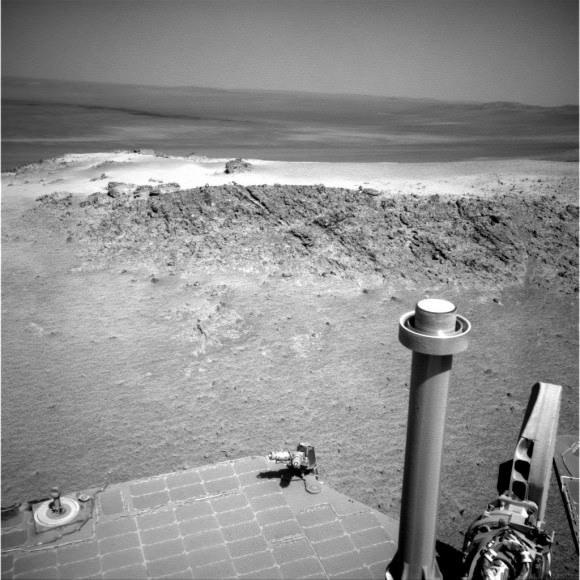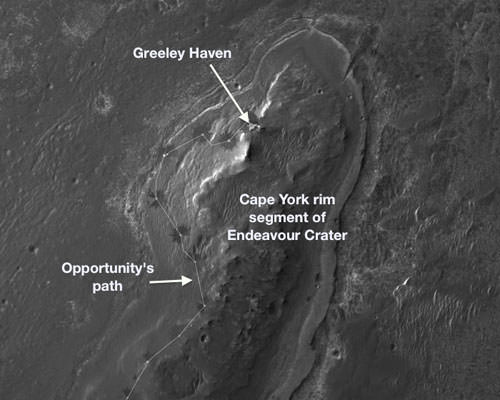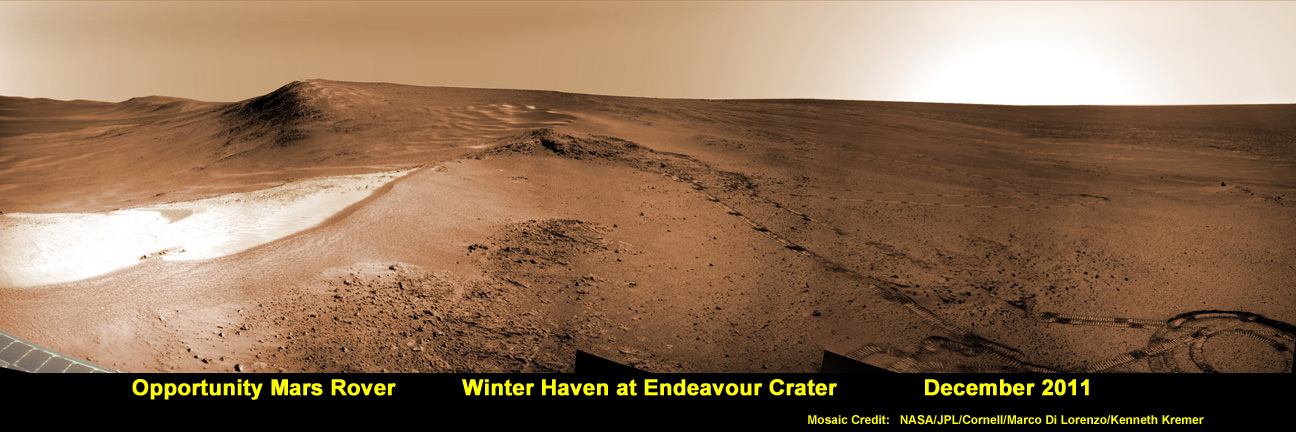[/caption]
NASA’s seemingly indestructible Opportunity rover has arrived at the breathtaking location where she’ll be working through her unfathomable 5th Martian Winter. The Opportunity Mars Exploration Rover has not only endured, but flourished for 8 years of unending “Exploration & Discovery” on the Red Planet despite having an expected lifetime at landing of just 3 months, way back in January 2004.
Opportunity is parked at a northward facing outcrop dubbed “Greeley Haven” where she can soak up the sun and juice her innards throughout the utterly harsh and Antarctic-like temperatures on tap for the next few months that threaten to kill her each and every Martian day. See our mosaic above around the Greeley Haven area.
Science team members told Universe Today that the rover is sitting at Greeley Haven because the site offers a roughly 15 degree tilt that will maximize the electric output from the life-giving solar arrays and also allow the robot to carry out a vigorous science campaign during the seasonal Martian winter season that officially begins in March.
Greeley Haven is a located at the northern tip of the “Cape York” segment of the western rim of the vast crater named Endeavour, some 14 miles (22 km) wide that’s loaded with a bountiful variety of rocks and soil that neither Opportunity nor her twin Spirit have ever touched and drilled into before and stem from an earlier epoch when liquid water flowed eons ago and perhaps may have been more favorable to sustaining life.
“Opportunity is currently sitting on Saddleback at Greeley Haven, an outcrop of impact breccias on Cape York, Endeavour crater’s rim,” Ray Arvidson told Universe Today. Arvisdon is the mission’s deputy principal investigator, of Washington University in St. Louis.
“Her northerly tilt is about ~15 degrees which is enough to have a vibrant winter campaign. The Martian southern winter solstice occurs at the end of March. A few months after that date we will drive her off the outcrop and further explore Cape York.”

Opportunity captured this view of a northward-facing outcrop, "Greeley Haven," where the rover will work during its fifth Martian winter. This southward-looking image was taken on Sol 2790 on Mars (Nov. 29, 2011). The rover team chose this designation as a tribute to the influential planetary geologist Ronald Greeley (1939-2011), who was a member of the science team for the Mars rovers and many other interplanetary missions. Credit: NASA/JPL-Caltech
“Greeley Haven” is named in tribute to planetary Geologist Ronald Greeley (1939-2011) who was a beloved member of the rover science team and a host of other NASA planetary missions. He taught at Arizona State University and inspired several generations of students and planetary scientists until his recent death on Oct. 27, 2011.
“We’ll hunker down at Greeley Haven as long as we need to, and we’ll do good science while we’re there,” Steve Squyres of Cornell University, Ithaca, N.Y., told Universe Today. Squyres is the Principal Investigator for Opportunity.
Opportunity is collecting a high resolution 360 degree panorama to commemorate Greeley.
Throughout the past 4 Martian winters, Opportunity had continued to traverse without pause. But this winter time it’s different because the solar panels are significantly more coated with an obscuring layer of dust hindering their energy output.
So the rover is parked with a tilt for her 5th Martian winter, mimicking the successful strategy power boosting used by Spirit to survive 3 harsh Martian winters.
And there is a silver lining to sitting mostly still that enables a chance to determine what’s at the core of the Red Planet, a key fact we don’t know.
“This winter science campaign will feature two way radio tracking with Earth to determine the Martian spin axis dynamics – thus the interior structure, a long-neglected aspect of Mars,” Arvidson told me.
I asked Squyres for a progress update and how long would the data collection require ?
Squyres replied that the experiment has already begun and added – “Hard to say how long. It’s months, as opposed to weeks or years, but it depends very much on data quality and the amount of data we get per week. We’re very early in the experiment now… we’ll just see how it goes.”

Opportunity will spend its fifth Martian winter working at Greeley Haven on the western rim of Endeavour Crater. Credit: NASA/JPL-Caltech/UA


well it’s easy to see what the next rovers will need.
countermeasures for dust and some sort of concentrating mirrors.(Mylar?)
It depends. Spirit and Opportunity were only designed to operate for 90 days, thus there was little point in burdening them with any solar panel cleaning equipment when every ounce was critical. Curiosity is powered by an RTG, and thus has no solar panels.
Clearly, if you’re designing a rover that is powered by solar cells and is required to last for years on Martian surface, then you need to consider the problem of dust accumulation, but even then, passive measures, like mounting the cells on sloped surfaces, and the greatly increased efficiency of modern and future solar cells, may preclude any necessity for a cleaning mechanism.
So, not as obvious as you might think 🙂
Nasa DID design a solar power system that lasted for years for both rovers. I’d be tempted not to mess with success unless you wanted to design a system that would last for decades.
Oh, it’s not rocket science.
“Self-Cleaning Solar Panels
A technology intended for Mars missions may find use on solar installations in the deserts on Earth.”
“The technology was developed for future rover missions to Mars, but it could work here on Earth to keep solar panels operating at peak capacity. It uses electrostatic charge to repel dust and force it to the edges of the panels. It can remove 90 percent of the dust on a solar panel in a two-minute cycle, says Malay Mazumder, a research professor at Boston University who led the work.”
“Mazumder’s technology is one of two approaches NASA has funded for cleaning off solar panels. The other vibrates the entire panel to shake dust loose. It’s still not clear which will prove more practical for space missions, says Surampudi, who oversaw the research into both dust-clearing techniques. Using vibrations is simpler and requires fewer modifications to the solar panel, he says. But it does not remove fine particles as well as the electrical field approach. For terrestrial applications, Mazumder’s technology will have to compete with other potential approaches to cleaning off solar cells without using water, such as blowing air on them or adding a nonstick layer.”
[Published August 26, 2010]
So re tacitus comment, one can surmise from this that in space launch weight added concerns constrain development.
well the 90 days scenario has always seemed like a very low bar to clear.
we now know how important it is to consider the airborne dust and mirrors are a very lightweight solution to maximizing sunlight.
solar powered rovers have proved their efficacy on mars and can be improved upon to do a lot more.
RTG’s scare congressmen.
The expected lifespan of both these rovers has been exceeded by YEARS! Kudos to the engineers that designed these two craft. And the Team that continued the exploration over the years! You People Amaze me to no end!